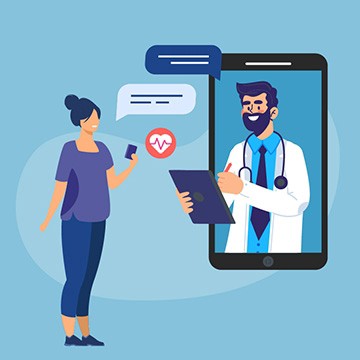The Community Hospital of the Monterey Peninsula is using digital health tools to improve care coordination and management with patients before and after surgery, while plotting a slow and careful approach to RPM.
HealthLeaders Media
BY ERIC WICKLUND
MAY 17, 2022
Key takeaways:
- Healthcare organizations are experimenting with digital messaging platforms to improve patient engagement leading up to and after hospitalizations, especially for surgeries, with the goal of reducing paperwork and improving care coordination and management.
- These platforms give providers an opportunity to help patients prepare for a procedure and recover better and more efficiently after the procedure, while providing data for payers looking for value-based care routines.
- They also lay the groundwork for remote patient monitoring, and allow providers to figure out the challenges and benefits before moving into that arena.
As healthcare organizations across the country expand their digital health footprint to improve care coordination, one California hospital is using targeting messaging and videos to help patients before and after surgery.
Community Hospital of the Monterey Peninsula (CHOMP), part of the Monterey-based Montage Health network, is using digital health tools provided by Force Therapeutics to not only
- better prepare patients for their upcoming procedures,
- but to ensure they transition quickly into prescribed recovery and rehabilitation programs.
“A lot of things have to be orchestrated within a certain period of time,” says Christopher Meckel, MD, an orthopedic surgeon with Monterey Spine & Joint, who’s been using the platform for patients undergoing hip or knee replacements.
“We used to do this with huge folders of paper, basically a huge data dump of paperwork, and phone calls. That wasn’t efficient.”
The shift from paper-based to digital hasn’t been easy, as anyone who’s ever dealt with an electronic medical records platform can attest.
The attraction and familiarity of seeing something written down is strong. But paper is cumbersome, and can be misplaced, lost, or destroyed.
What’s more, directions written down on paper can’t be updated or changed to accommodate new care plans unless one wants to print out another set of instructions.
But something that is available in electronic format is accessible at any time on a smartphone, laptop, or computer, allowing patients to access information when and where they need it.
And that information can be edited at a moment’s notice, allowing care providers to amend or change care coordination and management protocols as the patient progresses.
And there’s no paper to spill coffee on, have the dog chew up, or lose behind the sofa.
Meckel says Montage Health and CHOMP were early adopters of the electronic medical record, which he describes as “a pretty good repository of information.”
The challenge for many health systems has been to make sure the information is stored, analyzed, and used in ways that improve clinical outcomes as well as clinical workflows.
And that, in some cases, has taken a while to figure out.
“It’s become better [as a platform for] communication and doling out information,” says Meckel. “That’s where we saw this opportunity.”
Through the EMR, Meckel and his colleagues can send messages, care plans, even videos to patients, helping them to prepare in advance for a surgery and follow a prescribed course of action to recover from surgery.
“The fact that it’s asynchronous is fantastic,” says Meckel, noting the messages and information can be accessed by the patient at any time.
And it cuts down on time spent by the care team on the phone, setting up the next appointment or making sure the patient is following doctor’s orders.
This also helps the care team with what often are specific rehabilitation goals after surgery.
Care providers can set those goals early and remind patients ahead of time what they need to do when they’re at home (including using videos to demonstrate certain exercises).
They can monitor a patient’s recovery in near-real-time, as opposed to waiting for the patient to come back into the office or call about a health concern.
And with scheduled questionnaires, they can learn how the patient is doing every day, and spot trends or concerns that may need to be addressed.
“Some people tend to suffer in silence and think the pain they’re feeling [after a procedure] is normal,” Meckel says. ‘That’s why patient-reported outcomes are so important. They tell us more … than we might get” in a conversation in the office.
“You don’t want to miss a person who needs help,” he adds. “And you want to be able to answer the questions, ‘Do I have a happy patient?’ ‘Does this meet their expectations?’ ‘Am I doing what I need to do’” to improve their quality of life?
These messages, questionnaires, reminders, links to resources, and videos generated through the EMR to the patient not only improve engagement, they enrich the patient record with more data, allowing care teams to better document clinical outcomes and help the patient toward recovery.
They also provide important information to payers looking for value-based treatment plans and can be incorporated into bundled payment programs.
But Meckel points out the platform needs to be designed carefully, and that takes a bit of work on the provider’s side to choose the right questions and map out the right care plans.
“A lot of effort goes into designing this,” he says. “You need to choose the right questions, and everyone has to be” trained to not only schedule the questions but review the results coming back from patients.
“You want to be able to see that people are answering questions exactly the way you want them to be answered,” he says. “It forces us to sit down and decide” not only how to ask a question, but what a care team wants in the answer. Too direct or complex in one direction, or too vague in the other, and the answer will lead to more questions and won’t help form the care plan.
Looking into the future, Meckel says the messaging platform also lays the groundwork for remote patient monitoring, a care platform that many health systems are adopting to expand opportunities to treat patients at home.
In fact, it may be an ideal way for a small hospital or medical practice to learn the ropes and get the details worked out before advancing to RPM, which may involve telehealth visits and digital health devices that gather physiological data in the home.
Looking into the future, Meckel says the messaging platform also lays the groundwork for remote patient monitoring, a care platform that many health systems are adopting to expand opportunities to treat patients at home.
For his patients, Meckel wants to expand the platform to incorporate more videos and resources for home-based rehabilitation and exercise.
He’d also like to integrate some AI functions to help patients with the basic mechanics of exercise.
That’s the natural progression for how he’s using the platform and he wants to develop it carefully so that it doesn’t become too cluttered.
“We need to keep this as simplified as possible,” he says, or else his patients will become overwhelmed or lose interest. The easier and more intuitive the platform, the better the likelihood of keeping patients engaged and motivated.
Eric Wicklund is the Technology Editor for HealthLeaders.
Originally published at https://www.healthleadersmedia.com.
Names mentioned
Christopher Meckel, MD, an orthopedic surgeon with Monterey Spine & Joint











